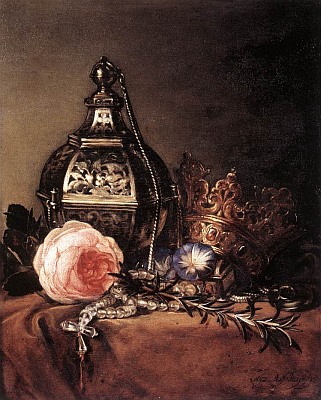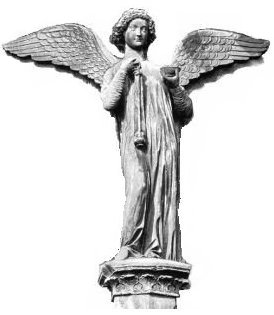
Psalm 140:1-2 "I have cried to Thee, O Lord, hear me: hearken to my voice, when I cry to Thee. Let my prayer be directed as incense in Thy sight; the lifting up of my hands, as evening sacrifice."
The "sweet savour" of incense was used in Old Testament liturgy as far back as the time of Moses as an offering to God:
Exodus 30:34-37... and its continued use was predicted, along with the Eucharistic offering, by Malachias:
And the Lord said to Moses: Take unto thee spices, stacte, and onycha, galbanum of sweet savour, and the clearest frankincense, all shall be of equal weight. And thou shalt make incense compounded by the work of the perfumer, well tempered together, and pure, and most worthy of sanctification. And when thou hast beaten all into very small powder, thou shalt set of it before the tabernacle of the testimony, in the place where I will appear to thee. Most holy shall this incense be unto you. You shall not make such a composition for your own uses, because it is holy to the Lord.
Malachias 1:11Frankincense as a sign of His Divinity, and myrrh to portend His Passion and Death, were two of the three gifts the Magi brought to Baby Jesus --
For from the rising of the sun even to the going down, my name is great among the Gentiles, and in every place there is sacrifice, and there is offered to my name a clean oblation: for my name is great among the Gentiles, saith the Lord of hosts.
Matthew 2:11-- and as portended, myrrh, with its analgesic properties, was offered to Him on the Cross and was used, mixed with aloes, to annoint Him after death:
And entering into the house, they found the child with Mary his mother, and falling down they adored him: and opening their treasures, they offered him gifts; gold, frankincense, and myrrh.
Mark 15:22-23Even the very angels in Heaven use incense, the smoke of which comes with the prayers of the Saints.
And they bring him into the place called Golgotha, which being interpreted is, The place of Calvary. And they gave him to drink wine mingled with myrrh; but he took it not.
John 19:39-40
And Nicodemus also came, (he who at the first came to Jesus by night,) bringing a mixture of myrrh and aloes, about an hundred pound weight. They took therefore the body of Jesus, and bound it in linen cloths, with the spices, as the manner of the Jews is to bury.
Apocalypse 8:3-4
And another angel came and stood before the altar, having a golden censer: and there was given to him much incense, that he should offer of the prayers of all saints, upon the golden altar which is before the throne of God. And the smoke of the incense of the prayers of the saints ascended up before God from the hand of the angel.
| The Catholic Church still uses incense, of course, in accordance with prophecy of Malachias, the fragrant smoke symbolizing our prayers rising to Heaven and purifying what it touches. The incense is kept in a covered, often boat-shaped liturgical vessel called, unsurprisingly, a "boat," which symbolizes the barque of Peter. The boat, made of bronze or brass and often silver or gold-plated, comes with a spoon for scattering the incense in the bowl-shaped matching burner, called a "thurible" or "censer." The thurible holds burning charcoal (or wood) to ignite the incense and hangs on chains (see angel picture below) so that it may be swung by the priest when censing things (or people) and so it may be easily carried by the thurifer -- the "Altar server" who assists the priest by carrying the incense. | Thurible & Boat |
Incense is also used during the Benediction of the Blessed Sacrament, during processions, funeral rites and to bless things like relics, bells or the Gospel.
Other uses of incense are the 5 grains of incense, symbolizing the 5 wounds of Christ, inserted into the Paschal candle on Easter, and the incense burned on the altar stone of a new Altar during its consecration. Incense is also placed inside the cavity (the "sepulchre") of the Altar along with a relic, to symbolize the prayers of the Saint to whom the relic belongs.
Also, frankincense is blessed on the Feast of the Epiphany. The faithful may take some of his home with them for use at their family altars.

Incense Use in the Home
Though stick and cone incense may be used during prayer and lectio divina, the classic way of using incense at your family altar is to use resin incense (like the priests use), which comes in large "grains," in a charcoal incense burner. Simply place a piece of charcoal in the burner, light it until it is glowing (it might spark at first), and place about a 1/2 a teaspoon or so of incense on top (not so much that the charcoal will be smothered). It is good to have a supply of those bamboo sticks that are used in making shishkabobs: they come in handy for lighting not only charcoal inside the burner, but for lighting tall pillar candles that've burned down deeply inside their glass holders.Charcoal can smolder for a very long time, so don't leave it unattended -- and remember that the incense holder will be hot, so keep little hands, and your own, away. You can find incense burner charcoal and a large variety of resin incense here and a large variety of incense burners here (links will open in new browser window).
If you don't have or don't want to buy a regular incense burner, you can use any fire-proof container -- bowls, a seashell, even -- for the purpose. Place a little sand for insulation at the bottom of your container if it sits directly on your table.

1 comment:
Nice post..
Post a Comment